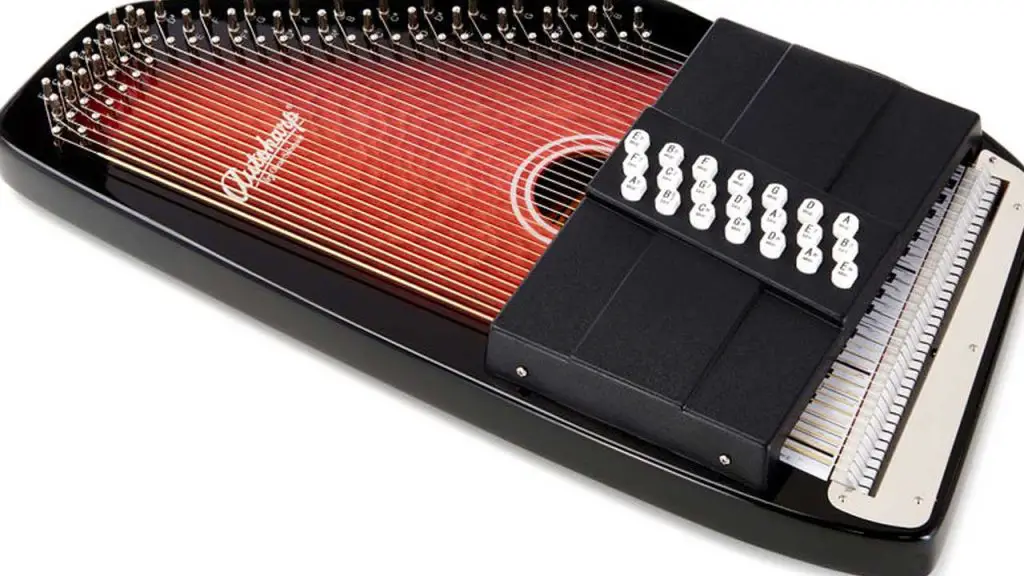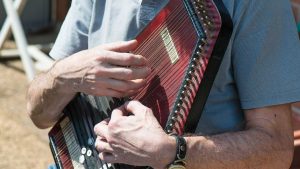Folkstrings.com is reader-supported. When you buy through links on our site, we may earn a small commission.
I’ve always been fascinated by how some musical instruments seem approachable even to the freshest of beginners, and the autoharp fits neatly into this category. With its modest size and characteristic shape, it houses a series of strings that can be strummed or plucked to create music.
What stands out about the autoharp is its design, which allows for simple chordal accompaniment to songs by pressing down chord bars.
This makes complex chordal structures accessible with ease.
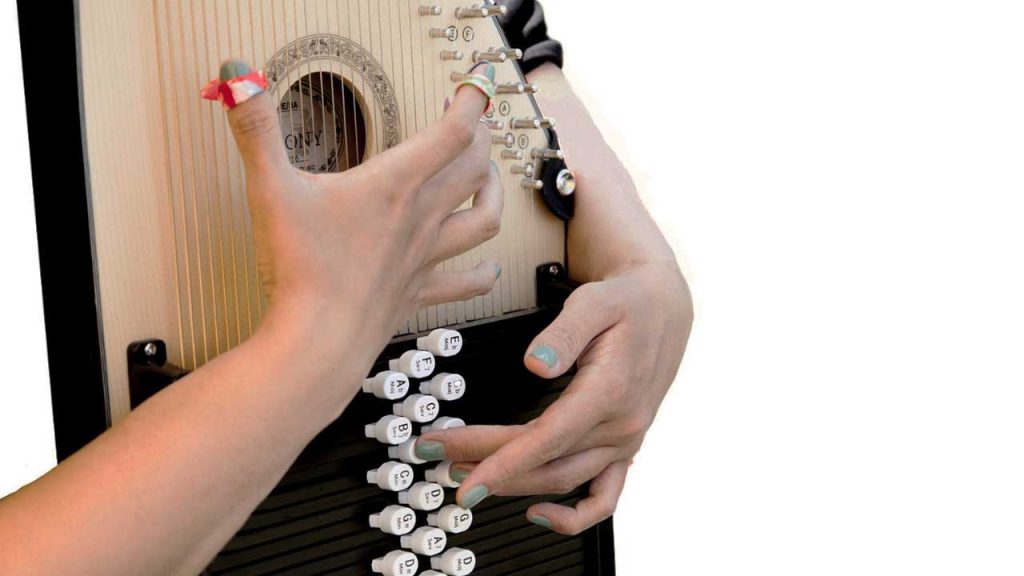
When I first encountered the autoharp, its simplicity was inviting. Learning to play it did not seem as daunting as some other stringed instruments like the guitar or violin, given that one doesn’t need to fret about finger positioning on the neck—there isn’t one. The chord bars manage the task of creating harmonious sounds.
However, while the basics may be easy to pick up, developing a nuanced skill set and a refined touch can take the same diligence and practice as any other musical pursuit. Like most instruments, the journey of mastery is a layered process, blending the ease of starting with the depth of complex musicianship over time.
With a range of prices and maintenance needs, the autoharp can be both accessible for beginners and appealing to seasoned musicians looking to expand their repertoire. The charm of being able to provide accompaniment to other instruments or play as a solo setup further broadens its appeal. Many music educators appreciate the autoharp for its ease of introducing musical concepts and its adaptability in ensemble settings.
Key Points
- The autoharp’s design makes it accessible for beginners.
- Mastery of the autoharp, like any instrument, requires practice and dedication.
- The autoharp suits various musical settings, from education to solo and ensemble performances.
Getting to Know the Autoharp
In exploring the Autoharp, I’m intrigued by its rich history and the unique construction that defines this instrument. I’ll guide you through the evolution of the Autoharp and its components, which contribute to its distinctive nature within the zither family.
History and Origins
I’ve found that the Autoharp has its origins in the late 19th century as part of the zither family. Charles F. Zimmermann, a German immigrant, was instrumental in its design and obtained a patent for the Autoharp in 1882. Zimmermann was a Philadelphia-based instrument manufacturer keen on creating an easy-to-play version of the zither, which he initially named the “autoharp.”
Ownership of the Autoharp’s patent and trademark ultimately passed to Oscar Schmidt, another name that grew synonymous with the instrument. It was Oscar Schmidt who marketed the Autoharp extensively, helping it gain immense popularity as a folk instrument, especially in the United States.
Anatomy of an Autoharp
Now, when I look closely at an Autoharp, I notice it’s a stringed instrument usually made from wood, featuring a series of tuning pins and chord bars. Here’s a brief rundown of its anatomy:
- Body: Typically fashioned from wood, the body supports numerous strings stretched over it.
- Strings: Made from metal, they vary in number but often there are 36 or more.
- Tuning Pins: Positioned on one side of the Autoharp, these pins are used to adjust the tension of the strings, thus tuning the instrument.
- Chord Bars: They press down groups of strings to form chords when the player pushes them.
- Chord Bar Buttons: Players press these buttons to activate the chord bars.
Some modern Autoharps may also include parts made of plastic or other materials, but wood remains a core component of traditional designs. The combination of wooden body, metal strings, and the mechanical simplicity of its chord bars makes the Autoharp distinct and relatively easy for beginners to start making music.
Learning to Play the Autoharp
I’m starting to learn that playing the autoharp involves learning proper techniques, understanding chord progressions, strumming, and selecting the right instrument. With practice, these elements will help me create beautiful music with my autoharp.
Essential Techniques
When starting out, I need to familiarize myself with the layout of my autoharp. It usually has 36 or 37 strings and up to 21 chord bars. I press the chord bars to make chords while strumming across the strings with my other hand.
To maintain proper tuning, which is crucial for sound quality, I use an allen wrench and an electronic tuner. I match each string to its corresponding note. Besides, I commonly use finger picks or a flat pick to strum the strings.
For clear sound, I must learn to use the dampers effectively. The dampers mute the strings that are not part of the chord I’m playing. Mastering this will prevent unwanted notes from ringing out and make my chord transitions smooth.
Chord Progressions and Strumming
To play songs, I must learn various chord progressions which are sequences of chords that complement each other. I also need to practice strumming patterns.
A steady rhythm is vital, and strumming can be done with a flat pick or my fingers, depending on what feels more comfortable.
Typical strumming patterns I’ll encounter include:
- Downstroke strum (strumming the strings toward the floor)
- Upstroke strum (strumming the strings toward the ceiling)
- Alternate strum (mix of downstrokes and upstrokes)
The autoharp makes it easy to play chords, thanks to the button-like chord bars. Each chord bar corresponds to a specific chord, and I press the bar while strumming to produce the chord.
Selecting Your First Instrument
Choosing my first autoharp, I’ll consider factors like size, string type, and the number of chord bars.
Not all autoharps are the same; some are diatonic (tuned to notes of a particular key), while others are chromatic, having more notes available for a variety of music genres.
A well-made autoharp should have:
- A sturdy frame
- Properly aligned chord bars for smooth playing
- Consistent string tension for reliable tuning
Remember, the type of music I want to play will influence my choice. If I’m interested in folk music, for instance, I might prefer a model commonly used in that genre.
The Costs and Maintenance of an Autoharp
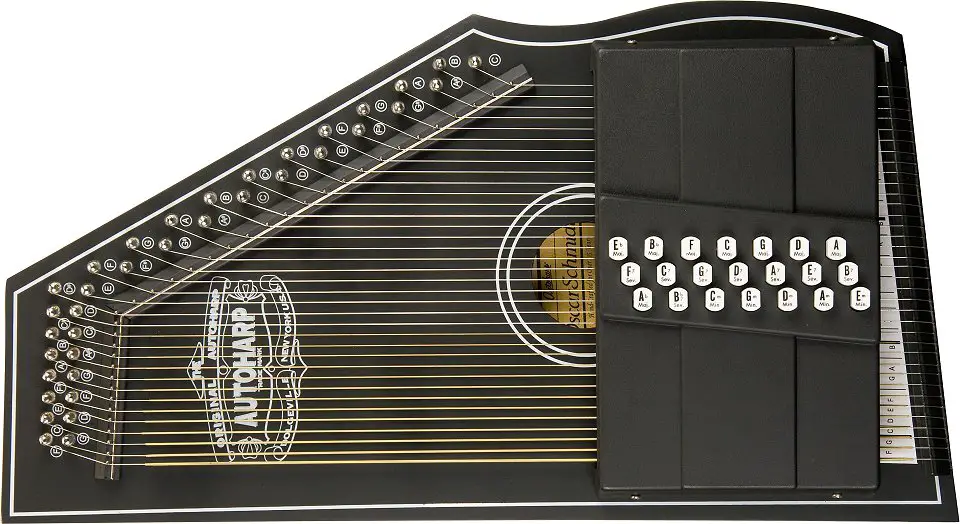
When I think about the autoharp, I consider not only the initial price tag but also the long-term care it’ll need to keep it sounding beautiful.
Initial Purchase
Buying my autoharp was an exciting step into the world of folk instruments. I found that the cost of a new autoharp can range from $100 for a basic model to over $500 for a top-tier instrument on websites like folkstrings.com or amazon.com.
The price can vary based on the brand, quality of materials, and the specific features. Visiting a reputable musical instrument dealer offered me the chance to hear and feel the instrument before making my investment.
Ongoing Upkeep
Once I had my autoharp, maintaining it became part of my routine.
Tuning is a regular task since the autoharp is a stringed instrument, and I’ve learned it can go out of tune with fluctuations in humidity and temperature.
I invested in a decent tuning wrench and an electronic tuner, which altogether cost me around $20-$40.
The strings, depending on how often they are played or break, can cost about $50-$100 to replace. I check the folkstrings.com or contact local dealers for the best quality strings.
Regular dusting and storing it in a case when not in use also goes a long way in keeping my autoharp in perfect playing condition.
Incorporating Autoharp into Music
I’ve found the autoharp to be a wonderfully accessible instrument to weave into various musical settings. Its inherent simplicity allows for easy integration, particularly within folk and country genres, which often embrace the autoharp’s rich chordal textures.
Genres and Repertoire
The autoharp fits comfortably within folk music, where its sound complements the storytelling nature of the genre. Folk melodies often revolve around vocal narratives, and the autoharp’s ability to provide a full chordal accompaniment enhances the musicality of these stories.
- American Folk: Traditional American folk repertoire commonly includes autoharp, with its chords underpinning the narrative-driven lyrics.
- Country Music: Similarly, country music frequently makes use of the autoharp’s rich sound, providing a harmonic foundation that is both lush and easy to blend with guitars and banjos.
One notable contemporary Canadian singer-songwriter who has incorporated the autoharp into her music is Basia Bulat. Her album Oh, My Darling is a fine example of how the autoharp can be featured in modern folk music.
Playing with Others
In a band setting, the autoharp can enrich the overall sound without competing for attention. Its role can be likened to that of the rhythm guitar.
The autoharp establishes a harmonic base that guides and supports the melodies and solos of other instruments.
- Harmonic Support: I use my autoharp to provide chordal accompaniment, allowing lead instruments like the guitar to play intricate melodies.
- Ensemble Integration: When I play with others, I find it’s essential to listen and find the right moments to strum or pluck the strings.
- Ensuring the autoharp’s sound complements rather than overwhelms is crucial.
Whether it’s a casual jam or a structured performance, integrating the autoharp calls for attentiveness to the dynamics and flow of the ensemble.
This enriches the collaborative musical experience.
Frequently Asked Questions
In this section, I’ll address some common inquiries about playing the autoharp, from the basics for beginners to its maintenance needs.
What are the basics of playing the autoharp for beginners?
This mechanism allows for simplified harmonization which is friendly to beginners.
Can you learn to play autoharp on your lap, and if so, how?
This position enables you to comfortably press the chord bars and strum the strings. Ensuring the instrument is stable is important to maintain control over your playing.
What is the difficulty level for learning the autoharp?
Beginners can play songs relatively quickly.
How often does an autoharp need tuning?
Once the strings have settled, I find it may need a check and slight adjustments every few weeks depending on use and environmental factors.
Do players typically use a pick when playing the autoharp?
This offers better control over dynamics and tone than using fingers alone.
What is the estimated time required to become proficient at the autoharp?
Some players achieve a comfortable level within a few months, while others may take a year or more to feel proficient.
Author Profile
-
Daniel Johnstone is an English writer with a love for stringed instruments from around the world.
He shares his love for these instruments through his writing for folkstrings.com, a website dedicated to all things related to folk string music.
Daniel's passion for music started at a young age, and he has since become an accomplished musician, playing guitar, cavaco, and recently, the harp.
His dedication to learning and sharing his knowledge of stringed instruments is evident in his insightful and engaging blog posts. Whether you're a seasoned musician or a beginner, Daniel's writing is sure to inspire and entertain you.
When he's not playing music or writing, you can find Daniel exploring new instruments and seeking out new sounds to share with his readers.
Latest entries
 AutoharpApril 4, 2024Is Autoharp Easy to Play? Unveiling the Truth for Beginners
AutoharpApril 4, 2024Is Autoharp Easy to Play? Unveiling the Truth for Beginners AutoharpApril 4, 2024What Is an Autoharp Worth? Your Guide to Pricing and Value
AutoharpApril 4, 2024What Is an Autoharp Worth? Your Guide to Pricing and Value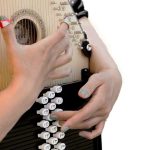 AutoharpApril 4, 2024Where Is the Best Place to Buy an Autoharp? Your Top Picks Reviewed
AutoharpApril 4, 2024Where Is the Best Place to Buy an Autoharp? Your Top Picks Reviewed AutoharpApril 4, 2024How Does the Autoharp Work? – Unveiling Its Melodic Secrets
AutoharpApril 4, 2024How Does the Autoharp Work? – Unveiling Its Melodic Secrets

